#apparently there was also a diagram of a brain and body that i drew and pasted onto my project but idk where it is
Explore tagged Tumblr posts
Text
presenting the topic of my ap bio final paper: the curious case of one kenny mccormick
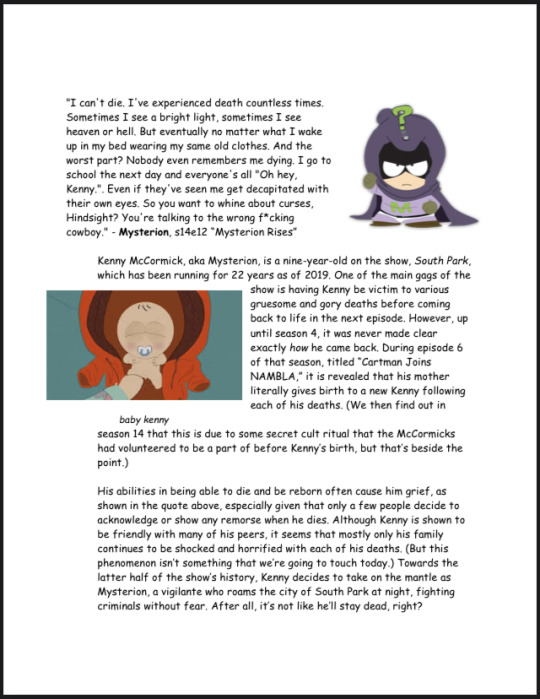

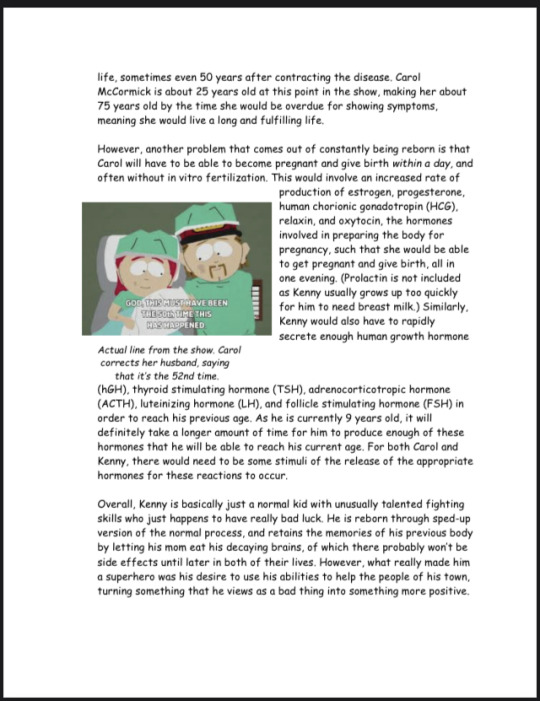
readable text and poorly done citations under the cut
"I can't die. I've experienced death countless times. Sometimes I see a bright light, sometimes I see heaven or hell. But eventually no matter what I wake up in my bed wearing my same old clothes. And the worst part? Nobody even remembers me dying. I go to school the next day and everyone's all "Oh hey, Kenny.". Even if they've seen me get decapitated with their own eyes. So you want to whine about curses, Hindsight? You're talking to the wrong f*cking cowboy." - Mysterion, s14e12 “Mysterion Rises”

Kenny McCormick, aka Mysterion, is a nine-year-old on the show, South Park, which has been running for 22 years as of 2019. One of the main gags of the show is having Kenny be victim to various gruesome and gory deaths before coming back to life in the next episode. However, up until season 4, it was never made clear exactly how he came back. During episode 6 of that season, titled “Cartman Joins NAMBLA,” it is revealed that his mother literally gives birth to a new Kenny following each of his deaths. (We then find out in season 14 that this is due to some secret cult ritual that the McCormicks had volunteered to be a part of before Kenny’s birth, but that’s beside the point.)

His abilities in being able to die and be reborn often cause him grief, as shown in the quote above, especially given that only a few people decide to acknowledge or show any remorse when he dies. Although Kenny is shown to be friendly with many of his peers, it seems that mostly only his family continues to be shocked and horrified with each of his deaths. (But this phenomenon isn’t something that we’re going to touch today.) Towards the latter half of the show’s history, Kenny decides to take on the mantle as Mysterion, a vigilante who roams the city of South Park at night, fighting criminals without fear. After all, it’s not like he’ll stay dead, right?
One of the biggest biological mysteries regarding Kenny’s rebirths is his ability to retain his memories, even within a brand-new body. It is often believed that one’s memories are contained within their RNA, and with brand-new RNA each time, it shouldn’t be possible that he would be able to have all of his memories back. However, with the idea of viable “memory transfers,” it is.
The memory transfer theory is that transferring RNA from one organism that has been “trained” to react in a certain way, to another organism (called the “naive” organism, where it hasn’t been “trained”) will cause the naive organism to have those learned reactions to certain stimuli. The idea is that, if we could figure out some way to inject RNA from Kenny’s dead body into his new body, then we could transfer the memories from his old body into his new one, as the memory transfer theory states. This is based off of McConnell’s experiment in March 1960, where they were able to successfully implant learned reactions from one planarian to a naive one. This was done by using the cannibalistic tendencies of a specific species of planarian, such that the naive planarians reacted to stimuli in the way that the trained planarians were conditioned to react.

Scientists have also begun to experiment with snails.
This implies that in order for Kenny to be able to retain his memories after being reborn, he would need to somehow consume brain matter (where RNA is made) from his former corpse -- something that would be pretty difficult for a newborn to do. As such, it is probable that his mother would have to consume Kenny’s brain for him, which comes with an entire other set of problems that have to do with the kuru disease (often likened to “mad cow” disease) due to the prions that she would be ingesting and putting into both herself and Kenny’s unborn self. However, the symptoms of kuru often don’t show up until later in life, sometimes even 50 years after contracting the disease. Carol McCormick is about 25 years old at this point in the show, making her about 75 years old by the time she would be overdue for showing symptoms, meaning she would live a long and fulfilling life.

However, another problem that comes out of constantly being reborn is that Carol will have to be able to become pregnant and give birth within a day, and often without in vitro fertilization. This would involve an increased rate of production of estrogen, progesterone, human chorionic gonadotropin (HCG), relaxin, and oxytocin, the hormones involved in preparing the body for pregnancy, such that she would be able to get pregnant and give birth, all in one evening. (Prolactin is not included as Kenny usually grows up too quickly for him to need breast milk.) Similarly, Kenny would also have to rapidly secrete enough human growth hormone (hGH), thyroid stimulating hormone (TSH), adrenocorticotropic hormone (ACTH), luteinizing hormone (LH), and follicle stimulating hormone (FSH) in order to reach his previous age. As he is currently 9 years old, it will definitely take a longer amount of time for him to produce enough of these hormones that he will be able to reach his current age. For both Carol and Kenny, there would need to be some stimuli of the release of the appropriate hormones for these reactions to occur.
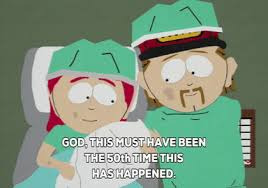
Actual line from the show. Carol corrects her husband, saying that it’s the 52nd time.
Overall, Kenny is basically just a normal kid with unusually talented fighting skills who just happens to have really bad luck. He is reborn through sped-up version of the normal process, and retains the memories of his previous body by letting his mom eat his decaying brains, of which there probably won’t be side effects until later in both of their lives. However, what really made him a superhero was his desire to use his abilities to help the people of his town, turning something that he views as a bad thing into something more positive.
citations:
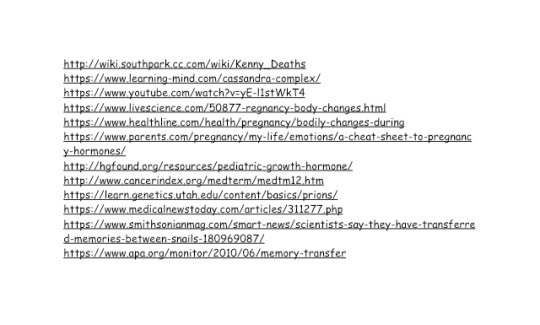
(tumblr wouldn’t let me actually paste the links 😐)
#kenny mccormick#carol mccormick#stuart mccormick#mysterion#south park#south park theory#apparently there was also a diagram of a brain and body that i drew and pasted onto my project but idk where it is#if i find it i’ll add an addendum#we’d had a couple different choices for our final project and i narrowed what i wanted to do down to#a paper finding a biological explanation for a superhero’s powers (mysterion) and a research paper on whatever research technology#(i would’ve liked to do my paper on deep brain stimulation but nooooo ms t thought it would be boring 😒)#i pulled so much shit out of my ass for this paper it almost makes me embarrassed#ALSO WHY DID I DO MY CITATIONS LIKE THIS???? NOT EVEN APA??? MLA????? NOTHING????#this is a fucked up theory tho right???#just realized that i said that carol is 25 in the show 🙄
121 notes
·
View notes
Text
The Sommelier (Hannigram x Female!Reader) pt. 10
Y/n and Will connect over a story. They put their heads together and come up with some ideas on where to find Chase.
Trigger warnings: sex trafficking, discussions of toxic relationships, codependency
This chaper also contains spoilers for the story Borrasca by CK Walker so if you haven't already read/listened to it and you want to, save this chapter for later.
Charissa was far deeper into astrology than anyone else you knew. No matter how many times she tried to explain it to you, you could never keep all the vocabulary straight. As much as you liked to indulge her pseudo-spiritual special interest, you never considered yourself a believer.
That was, until you met Will Graham.
One metaphysical concept was suddenly crystal clear to you; that of the twin flames. At first, you thought it was just a slightly dressier version of soulmates. But soulmates had to be complimentary, not identical. If you jumbled the pieces of your respective broken souls, you’d find that they fit together in a way in which you couldn’t determine where he ended and you began.
Charissa had warned you of the dangers of a twin flame romance. Both parties had to be mentally and emotionally literate, or else they could develop a toxic codependent relationship. Considering that neither you nor Will were the picture of mental health, you had to tread lightly. Having sex with him was probably just throwing gasoline on the dumpster fire your life was quickly becoming, but an extinguisher was within arm’s reach. You told yourself that if you just held on a little longer, this could be the start of something wonderful.
However, while pondering all this, you left out the crucial detail that you and Will’s shared self-destructive tendencies didn’t extend to how you treated other people. You were both very nurturing and consistently placed the needs of others over your own. And this dawned on you when you emerged from the bathroom, freshly showered and greeted with the smell of food.
“Is that my shirt?” Will asked, peering over his glasses at you.
“Oh, yeah.” You tugged at the oversized undershirt he’d slept in the evening prior, which you had snatched from the floor while he was in the shower. “I figured that the dogs would be less intimidated with a stranger in the house if I smelled like you.”
Will narrowed his eyes, his suspicion eclipsed by a smile. “Sure.”
You sniffed the air. “What are you making?”
“Reubens.” He lifted the pan slightly to show you two ugly but delicious-smelling sandwiches.
“At eight in the morning?” You laughed, shoving your hands into your pockets.
“Do you not want one?” He raised an eyebrow.
“Oh, I want one.” You put your hands up in surrender.
Will flipped a sandwich over and it sizzled against the hot pan. “By the way, Jack called. He wants to see both of us at the lab today, given that you’re up for it.”
“Sure.” You leaned over the counter. “What about?”
“He wants me to examine the body of the cultist.” He explained. “Thinks maybe you can help. He also wants you to give an official statement. Apparently the national news is starting to pick up on this story.”
“I won’t have to appear on TV or anything, will I?” You asked. “That would kind of defeat the purpose of me hiding out here.”
Will slid one of the sandwiches onto a plate. “I don’t think so. He just wants you to tell the record what you know so local police forces know what to look for and so CNN has something to report on.”
“That’s fair enough, I suppose.” You took a seat at the counter, your mouth watering from the smell.
“So you know how Kimber and Kyle are siblings?” Will said, placing his plate next to yours.
You froze and put your sandwich back on the plate. “I know that, how do you know that?”
Will paused and looked away, shamefully. "I couldn't sleep last night."
"So you listened to the entire story?" Your eyes widened in shock. "The entire, seven-hour-long story?"
"I wanted to know why," Will pulled his chair closer to the counter. "Out of all the literature in the world, last night made you think of Borrasca. So I listened to it."
You took a bite of your sandwich and wiped your face with the back of your hand. "I think it was just because it has to do with sex trafficking."
"But it wasn't sex trafficking until Sheriff Walker took over, was it?" Will said. "Or at least, not according to Jimmy Prescott."
"Shit, you did listen to the whole story." You said through a mouthful of sandwich. You swallowed.
"I think there's something else there." Will hypothesized. "There's something we can take from the story that could lead us to Mulvaney, just like with NXIVM and Handmaid's Tale."
“Okay, but,” You began. “She pretty explicitly referenced both NXIVM and Handmaid’s Tale. I brought up Borrasca on my own.”
“But you did it for a reason.” Will insisted. “Just humor me, please.”
You shrugged. “You’re the professional here. By all means, follow whatever path this story takes you down if you think it’s going to get Mulvaney behind bars.”
Will nodded and reached for a pad of paper. He drew a three circle Venn diagram and assigned a story to each circle. “What do NXIVM, Handmaid’s Tale and Borrasca all have in common?”
“Sex trafficking.” You said bluntly.
“Well, yes-” Will shook his head. “But, broader. Think about the how and why.”
“Uh,” You racked your brain for the how and why. “Dehumanizing women? Turning them into property?”
“Right.” Will scribbled something that vaguely resembled what you said in the intersection of the three circles.
“They all have a sort of charismatic figurehead.” You continued. “Keith Raniere, Fred Waterford, Jimmy Prescott.”
“And each of those men had their respective degrees of power and influence.” Will added.
“But Borrasca was relatively self-contained.” You countered. “Drisking was a small little nowhere town. It was out of the way so the corrupt local police and rich families could hide the town’s fucked up secret from the rest of the world.”
“You’re on to something.” Will said, tapping his pen against the table. “Chase Mulvaney isn’t a Keith Raniere, but he wants to be. He’s Jimmy Prescott.”
“You think this is a family operation?” You narrowed your eyes.
“I think he’s operating this cult using family money.” Will began to click the pen rapidly as he processed his thoughts. “And family land.”
“So we're looking for some kind of reform camp." You concluded. "Probably one that targets young women and girls."
"Something religious, too." Will added. "But not like, a convent. He's preaching faith-based salvation so he's definitely not Catholic."
"Definitely either Southern Baptist or Evangelical." You agreed. "Or maybe some sort of strange non-denominational offshoot."
"Like those people who don't like the word religion but advocate for a christian theocracy in the US." Will muttered.
"Yeehawdists." You said under your breath.
Will cracked a small but noticeable smile at your stupid pun.
"I think we might be on to something here." Will said, an optimistic upturn in his voice. He stood up from his seat and shoved the paper in his pocket.
He grabbed your hand. "Come on. If we get to Quantico soon, I'll bet we can nail this guy tonight."
#hannibal lecter#hannibal x reader#hannibal nbc#hannibal x you#will graham#will graham x reader#will graham x you#hannigram x reader#hannigram#the sommelier#fanfic#tw sex trafficking
127 notes
·
View notes
Text
Six Prince Consort Monster AU
That titles a mouth full...
Here’s the Monster AU version of @redladydeath‘s Six Prince consorts spinoff, the species where chosen by her

Geoffrey - Griffon
Guildford - Hydra
Phillip - Gargoyle
William - Amphibian Man
George - Satyr
Albert - Owlman
And now for some individual analysis...
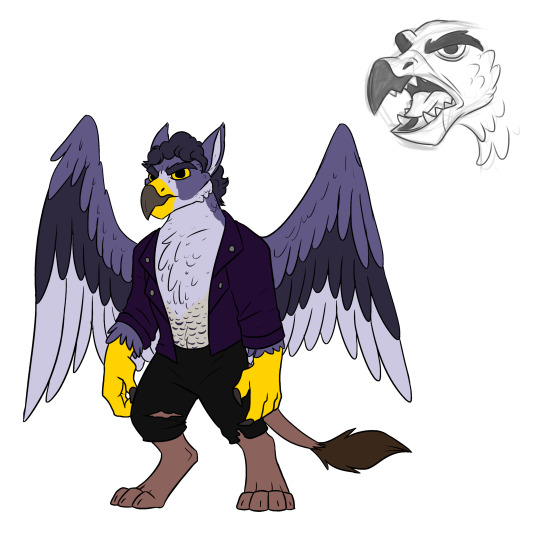
Geoffrey: His bird part is based off a peregrine falcon, but his skull is inspired by ceratopsian dinosaurs (because there’s a theory that the idea of Griffons came from a misidentified Protoceratops skull)
and yeah, he still has teeth
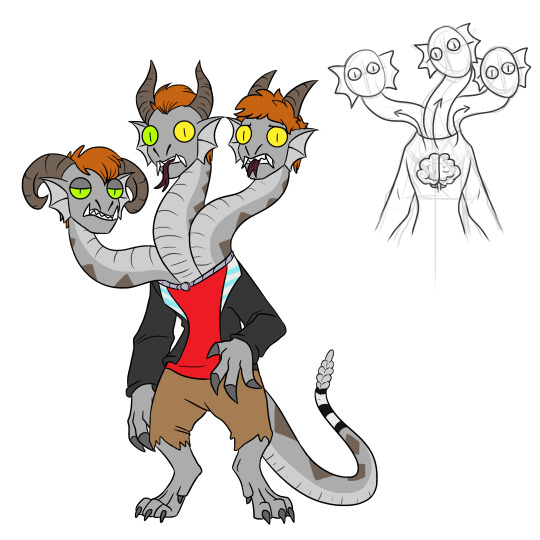
Guildford: He’s based off rattlesnakes, because I wanted to do something different with the tail.
And as the diagram I drew shows, his brain’s not in his heads, it’s in his chest, and is connected to all three heads. This means that his three heads don’t have different personality's, there are all extensions of the same consciousness. This is also why Hydras regrow heads so easily.
His main head is the center one and is ‘the real him’ and the one in control, he can move the rest of his body while the others can’t.
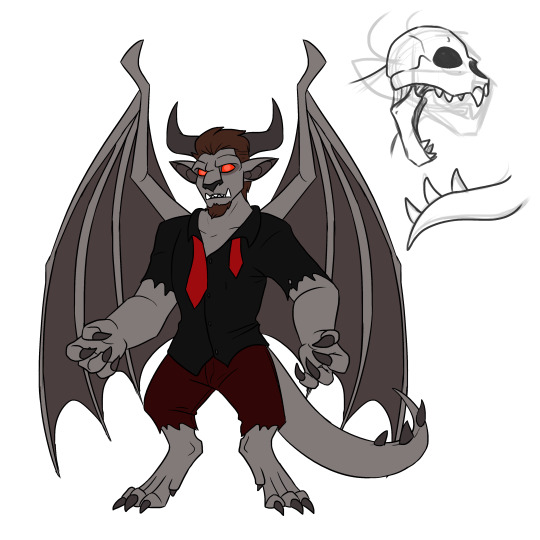
Phillip: I have my own big species profile on gargoyles in this universe. Here, gargoyles are much like elephants in terms of social structure. Females stay together in complex groups, whereas males are mostly solitary. The two sexes come together for breeding and nothing else.
Makes perfect sense for Phil here, as he spent as much time as he could away from Mary. Now he doesn’t need an excuse, it’s his nature.
Also Peyton suggested that he has a wide opening jaw like a thylacine, due to his Habsburg genes. This isn’t a normal gargoyle thing, he’s just got wild genes
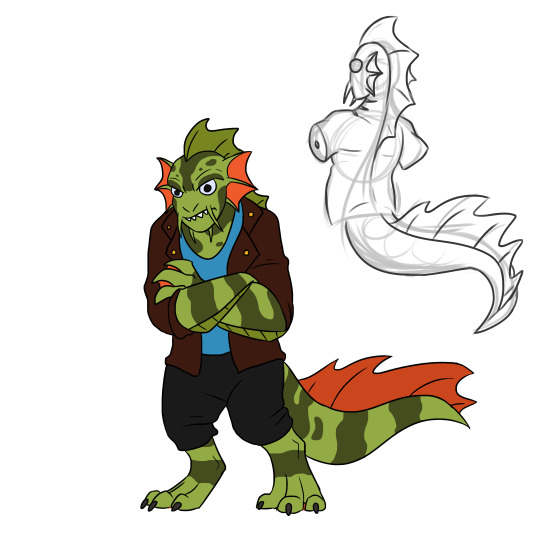
William: The least happy with his situation.
He’s like the Creature of the Black Lagoon, or the Amphibian man is you’re a Del Toro fan like me. He is basically 1/3 human 1/3 Tiger salamander and 1/3 Redtailed Catfish
This is because in real life, he was apparently a very short, ugly man and he got called ‘Caliban’ a lot (Who’s a character from Shakespeare’s ‘The Tempest’) and Caliban is usually portrayed as a gillman.
Just after William thought he was free from all that mockery, he becomes a literal swamp monster, poor guy.

George: Not much to say about George, the image kinda speaks for itself.
As the doodle says he’s pretty much full Dionysian, the wine, the partying, and now the goatness. I used a West Caucasian Tur as reference for his fur and horns.
Also in my universe Satyrs (Not fauns, don’t confuse them) are basically bonobos. The bang whoever, and whenever and are always PANsexual (geddit)
So becoming a satyr may involve gaining a satyrs all-encompassing sexual orientation. Which would be a shock.

Albert: There’s a lesser known cryptid from Britain called ‘Owlman’ it’s like Mothman! but more explicit with the Owl influence.
He’s a mix of both Barn Owl and Eagle Owl, and I tried as hard as I could not to have him look too much like Stolas from Helluva Boss, buuuuut the purple was already there.
Like Geoffrey, he also still has teeth despite being avian, and he has Amalia’s ‘wing-hands’ because archaeopteryx
#six#six prince consorts#six kings#Prince consorts of England#I don't know what this spinoff is called#monster au#six monster au#geoffrey of anjou#guildford dudley#philip ii of spain#phillip ii#william iii#william of orange#george of denmark#prince albert#griffin#gryphon#hydra#gargoyle#amphibian#gillman#fishman#amphibian man#satyr#owlman#my art#rowans art
47 notes
·
View notes
Text
Dean Kenning, Social Body Mind Map

I just finished reading and making notes on (using the Digestion System I employ to get around my badly limited memory, which is i think detailed in an earlier post) a paper shared with me by the artist and lecturer Dean Kenning. I’ve known Dean’s work for a while, we’ve been on panels and in exhibitions together going back 5 years or so, but this is the first time I’ve been able to got through a text to understand this system which he uses in teaching. I’m going to attempt to summarize it briefly here, and then talk about what happened when I tried the system myself.
Dean sets up the context for the workshop against increasing pressures in the UK on art education. The system of education in this country is primarily based around learning, recalling, and appling pre-existing methods and facts on demand, to satisfy predetermined outcomes. This is a problem because it is both incompatible with learning art, but also therefor discounts art and the definition of “thinking” it embodies. The thinking in art is generative, rather than prescriptive. There are ideological reasons for this which Dean doesn't go into but which should be fairly obvious in relation to school as site of labour discipline and enforcer of pre existing hierarchies of thought and power.
The “Social Body Mind Map” is method of understanding an artwork in particular, and art making in general as not arising from either a pre established set of ideas, or from an inscrutable and unknowable mystical self. It does this through the use of “the diagram” which i will return to, but first the aim of the workshop which this system is delivered to students by is characterised within its name, and the pairings of the four words. The “Social Body” reminds us that this is primarily about understanding self not as an autonomous individual but as the expression of multiple flows through one’s body connecting to things outside of it over time. The “self” (and Dead draws from Deleuze here) is better understood as an area where possibilities and influences converge. I wont go into more detail than that, as explaining this is in part what the workshop does. the second pairing is “Body Mind” and this emphasises that the thinking is something we do with our bodies rather than in some abstracted upper hierarchy. In fact Dean proposes the SBMM is a process of thinking through a diagram. Finally the paring “Mind Map” is a recognisable one to most students and is there to add a recognisable position to begin from. Dean’s mind map is not the same as the spider diagrams we might learn in school though for an important reason. Normally the mind map begins with a clear central position, the subject being “brain stormed”. Dean rightly points out that this standard method generally results in the reinforcement of existing structures, it favours cliches especially at first. Dean’s mind map will change this, by having the central position occupied by a partially unknown quantity. This unknown quantity will be “the art work”, which can be a completed, in progress or future one. Dean’s aim for this is as already stated to allow art works to be understood not as the reflection of some static self but as "generative of a subject”. The aim is also to articulate the “thinking” involved in art which is also generative. Finally, in order to achieve the latter, the workshop uses the former to “alienate the student from their work”, to make the artwork strange and not simply a “reflection” and therefore grant them agency in the process of production of thought.
Workshop stage 1
the workshop begins by prepping the participants to think of where an artwork arises from other than just as a reflection of some unknowable constant self. Dean draws up a series of headings under which as a group they list the things which answer broadly the question “that facilitated this artwork coming to be?” the headings are
Capacities (things like: perception, imagination, strength, emotion etc)
Motivations (things like: Will, pleasure, boredom, instruction, deadlines)
Resources (things like: materials, tools, support from teacher, friends etc)
Organisations (things like: school, galleries, manufacturers, government etc)
So thinking about the production of the artwork moves from “I used my imagination” alone, to a series of statements such as “i used perception of the feeling of clay to see what forms it could hold without collapsing” and “The government set a syllabus which means is followed by my teacher who sets the deadline of two weeks to produce this artwork” and so on.
workshop stage 2
Dean then leads and example mind map, having already primed the students to think about their work in terms of these networks. the mind map begins with a “?” in its centre, and Dean tracks the influences which converge in this central point which is procedurally redrawn as “the artwork”.
Students then do their own, on their own, drawing on large paper this network. of factors which caused this artwork to be. Dean has some good examples of how a student, whos central image the wardrobe grew a giant toe in the drawing. The toe is in fact the act of student stubbing their own toe against the wardrobe in the dark which has identified as a factor in why they were drawn to make an artwork about it.
Dean’s recounting of conversations with students show that this workshop serves to uncover unknown or disregarded factors in the production of artworks. its described as “digging up hidden roots”. I think this is really important, I very much remember the feeling of art production as something “mysterious” in the sense that it was obscure. Following that pop cultural ciche of art just arising from some internal genius, that art was a reflection of the character or soul of the person making it. The process of production of ideas was not something I ever saw discussed in any art school I studied in including at Masters level. I understood in the second year of my MA that emotions where important, specifically that I could not make work when anxious, and I also developed rules around when during its cycle of development/production/reflection I would analyse a work (I’m currently deliberately breaking this rule, having adhered to it for over 10 years, specifically so I can understand it better, but thats another post)
Finally what also of note, is the manner in which the capacities/motivations/resources/organisations are connected to the alienated central artwork in the diagram also become important. As with everything in Dean’s system, there’s no prescribed way to do it, but in drawing out a line as a big toe, or casually decided as in mine to draw “fear” as the contents of a specimen jar this opens up further layers of reflection. This is a process of achieving that art teacher mantra of “letting go”. How you draw the limbs or tentacles becomes important without being anxiety provoking up front.
Final final note, as stated all of the system is adaptable and emergent. The lists of capacities etc as just an example, and they are generated with the group including the potential for entirely new categories. I copied Deans example list into my notebook above, and used both that and further examples as and when i thought of them .
My SBMM for “Ok, Welcome to the black parade”

OWTTBP is an artwork I started, and then deliberately let stall and left incomplete a couple of weeks ago because I wanted to write about the process of making it (even though this breaks a rule I’ve long followed, which is to not take apart works in progress, but to only analyse my works when there is at least one completed work between them and what I am working on now, my “one work buffer” rule). Reading Dean’s model for SBMM seemed like a perfect opportunity to work on this Reanimator corpse that I had left partially assembled, and also understand the process Dean is talking about better through employing it.
[Briefly, the “artwork” as it stands is a short science fiction story, written to an arbitrary formal constraint of 5 line paragraphs for the majority of the text. There are two points where this 5 line pattern deviates. firstly there is a section where the paragraphs all begin “You wake up...” for 7 paragraphs (there are around 50 of the 5 line paragraphs, paras 31-37 begin with “you wake up”. Secondly, after the narrative in the 5 line paras ends, there is an epilogue, which loosely sticks to 2 line paras, and has a different tone of voice. The artwork so far exists as this narrative, and a structure whereby I want something to happen between each of those 5 line parars (excluding the block which begin “you wake up”, which are back to back, in the manner of the scenes of strobing in and out of consciousness we are familiar with in cinema) which pulls the audience out from the narrative into an unstable space. Likewise there will be unstable space between the paras of the epilogue, but where I understand the former unstable space to be disordered but partly intelligible, the space between the epilogue paragraphs should be utterly ahuman.]
Above in pink is a diagram I had already developed (there is another one in the post before this) on my own to try and understand the art work I had made. the Diagram using SBMM is right at the top of this post, drawn by hand in my notebook. What became apparent when drawing is that the diagram was going to be much larger than i had space for. There are threads which I felt dissatisfied with because i knew there was so much more detail which had been left out due to the “resolution” I was working at. For example, the first thread I drew was the “Verbal tic” head at the 12 o’clock position in the diagram. I have verbal tics which occur mostly when I am stressed and/or struggling to manage my intrusive thoughts. It feels like trying to tap alt-f4 with my brain or shake and etch-a-sketch. What I happen to mutter in the form of these tics goes through phases and for whatever reason, I had been muttering “Ok, welcome to the black parade” for a few weeks at the point when I decided to write a new story, and this become the image I began with, a character repeatedly muttering a statement about a My Chemical Romance song (which I must admit, at the time, I hadn’t even knowingly heard, i just knew the name).
My point is, that Verbal tic head could itself have expanded with multiple growths outward which followed the trains of why I came to be muttering that, how I had come into contact with the phrase, how I had experience in my practice of taking an arbitrary starting point to jump start a work, how I like the Becketian aspect of my tics which make language alien, how I like the repetition, how they connect in both directions of causality to anxiety (they are caused by stress, but they also draw attention to me) and so on and so on.
In closing, I think SBMM is a fantastic system, and its refreshing to try someone else’s system of diagrammatics, rather than my own which is utterly organic and chaotic (see pink diagrams, and the monkey-goth drawing at the end of this post which I drew to write the “ok, welcome to the black parade” narrative from). I’m currently prepping material to write the section of my thesis which is about diagrams, and Dean’s system is going to be in there, especially as it serves a very good bridge between the chaotic-code-switch which i employ for practice and the much more structure systems I use for written research such as the Digestion System.
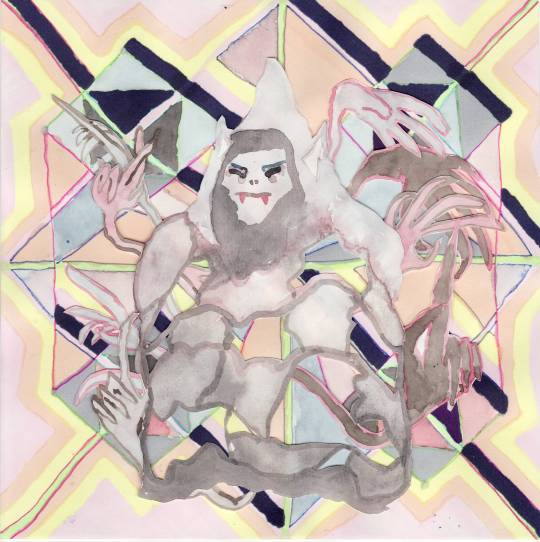
#art#dean kenning#deleuze#diagrams#phd#research#drawing#science fiction#animals#horror#art research#art practice#uma breakdown
18 notes
·
View notes
Text
Unit 2 Project - English 1010
Sariah Rose Peckham
Justin Jory
English 1010
27 July 2017
Unit 2: Rhetorical Analysis of Comparing Two Texts
Both Blue Collar Brilliance by Mike Rose and Shop Class as Soulcraft by Matthew Crawford share a similar theme: valuing the basics and importance of manual labor. While I feel Rose brings a more whimsical, emotional tone to the table, Crawford presents with lecture and technical style – this allows the readers to feel the passion for both of their main ideas but on completely different ends of the spectrum. Rose wants the audience to remember not to overlook the ones in society who work in blue collar jobs, as there is so much more going on cognitively and physically that goes far beyond what the eye can see. Crawford’s focus is on the importance of learning manual trade skills. In return, he wants the audience to know that there can be much pride, independence, and an abundance of value in learning a trade/craftsmanship.
Mike Rose’s biggest rhetorical strategy to compliment his main points was his use of storytelling and imagery. It was incredibly effective for the audience as you are able to develop a visual perception of his stories while also making an emotional connection because of his personal attachments. Whereas Matthew Crawford drew from the strategy of claims of fact and value – this appeals to the reader by forcing you to reflect on what is being said and what he means by saying it.
Rose writes, “I couldn’t have put it in words when I was growing up, but what I observed in my mother’s restaurant defined the world of adults, a place where competence was synonymous with physical work. I’ve since studied the working habits of blue-collar workers and have come to understand how much my mother’s kind of work demands of both body and brain. A waitress acquires knowledge and intuition about the ways and the rhythms of the restaurant business. Waiting on seven to nine tables, each with two to six customers, Rosie devised memory strategies so that she could remember who ordered what. And because she knew the average time it took to prepare different dishes, she could monitor an order that was taking too long at the service station.” (Mike Rose, Blue-Collar Brilliance) as part of his introduction, and it provides the reader with vivid imagery of his mother Rosie and the prioritizing and organizational skills she has acquired. It gives a more valuable and emotional insight to the intelligence and discipline Rosie has because of her blue collar position – the purpose of this would be to connect you, the reader, to his mother, Rosie.
It is clear that Rose wants you to look at blue collar jobs in a new light and with newfound respect – he expresses his take on the modern working industry by saying, “Our cultural iconography promotes the muscled arm, sleeve rolled tight against biceps, but no brightness behind the eye, no image that links hand and brain.” This is a beautiful string of words that appeals to the mass depiction of what most of society believes blue collar jobs to look and feel like. It is true, too! By carefully shaping an image of blue collar workers with his verbal metaphor, you are able to better resonate with what Rose is trying prove to the audience. The visual stigma sucks you in and forces you to reflect upon it.
Rose’s entire article is incredibly engaging due to his storytelling depictions. The audience is left impacted with the fact that his general focus was that we often overlook the values of such workers and jobs rather than the thought, time, and often meticulous environments that our people work in.
Matthew Crawford uses his claims of fact and value by saying, “Craftsmanship entails learning to do one thing really well, while the ideal of the new economy is to be able to learn new things, celebrating potential rather than achievement. Somehow, every worker in the cutting-edge workplace is now supposed to act like an “entrepreneur,” that is, to be actively involved in the continuous redefinition of his own job.” (Matthew Crawford, Shop Class as Soulcraft) Here, Matthew is laying fact of what craftsmanship actually entails and the value that follows! Simultaneously, another fact of the matter is that now cutting edge workplaces want you to have different work ethics so that you can be actively involved in a constant change instead of being good at the one thing you know how to do. I like that it is giving you insight into the facts of today’s modern working world but also allows you to look back on the values of what it has been. This effectively allows the reader to think beyond ideals of just going to college for the education. Crawford really wants the readers to be able to reflect on their current educational and career pathways.
Crawford also takes time to elaborate on his main idea by sharing facts about cars, of all things. He says, “At the same time, an engineering culture has developed in recent years in which the object is to “hide the works,” rendering the artifacts we use unintelligible to direct inspection. Lift the hood on some cars now (especially German ones), and the engine appears a bit like the shimmering, featureless obelisk that so enthralled the cavemen in the opening scene of the movie 2001: A Space Odyssey. Essentially, there is another hood under the hood. This creeping concealedness takes various forms. The fasteners holding small appliances together now often require esoteric screwdrivers not commonly available, apparently to prevent the curious or the angry from interrogating the innards. By way of contrast, older readers will recall that until recent decades, Sears catalogues included blown-up parts diagrams and conceptual schematics for all appliances and many other mechanical goods. It was simply taken for granted that such information would be demanded by the consumer.” This shares fact that manual trade work has become more efficient throughout the times, more quickly to be resolved rather than what it used to be. Lots of time, sweat, effort to get your car rolling again. This small paragraph points out that trade work is not as needed as it used to be anymore, and this appeals to the audience by forcing you to think of the value of all of the material things in our life that are handmade by people around the world. As a reader, you’re left going, “Oh, I didn’t think about it like that before.” Following this, the 2001: A Space Odyssey reference shows a secondary strategy use of tone/voice to his readers. He does this so that readers of all age can relate to what he is saying and better understand the depth of what he is trying to explain by comparing it to a very popular cult film.
Both writers had an audience in mind when writing their articles: I believe that overall, the essays were geared towards individuals who are currently working on a certain career path, and pursuing this by educational means. This can be validated because both essays were published on scholarly websites where many students, alumni, and educated like-minded people may visit often. More specifically, I’d say the aim of both essays was to open a door to young students in a perspective direction that which allows them to reflect on blue collar work and the importance of not forgetting how important service industry and manual trade jobs are within society.
In conclusion, Rose and Crawford both created analytical and thoughtful articles by using rhetorical writing strategies. Both authors demonstrate intelligence and compassion in their own respective pathways by finding unique ways to express their points and solid supporting ideas. Rose leaves his audience with a newfound perspective of blue collar positions, and society’s reflection upon them, no matter the role. Crawford manages to quite literally persuade you into taking up manual trade and/or a craftsmanship for whatever purpose, as there are many.
Works Cited
Rose, Mike. "Blue-Collar Brilliance." Theamericanscholarsh.org. Phi Beta Kappa, 1 June 2009. Web. 27 July 2017. <theamericanscholar.org/blue-collar-brilliance/#.WYTzY_ZlLcs>.
Crawford, Matthew B. "Shop Class as Soulcraft." Theatlantis.com. The Center for the Study of Technology and Society and Ethics and Public Policy Center, Summer 2006. Web. 27 July 2017. <http://www.thenewatlantis.com/publications/shop-class-as-soulcraft>.
0 notes